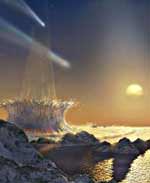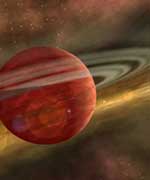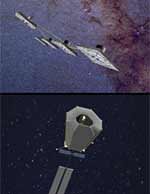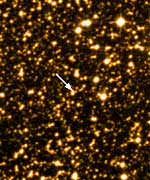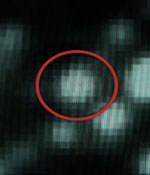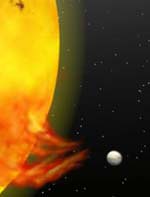Until a decade ago, astronomers weren’t even sure there were any planets outside the Solar System. You’d be hard-pressed to find anyone who believed we had the only planets in the entire Universe, but we still didn’t have any direct evidence they existed. That all changed in October 5, 1995 when Michel Mayor and Didier Queloz announced they had discovered a planet half the mass of Jupiter orbiting furiously around a star called 51 Pegasi. The discoveries came fast; at last count, there are 122 confirmed extrasolar planets.
But these extrasolar systems generally look nothing like our own Solar System. Many contain massive planets which orbit extremely close to their parent star; no chance for life there. Planets roughly the size and orbit of Jupiter have been uncovered, but it’s impossible for the current technology to see anything the size of our own Earth.
Fortunately, there’s a series of ground and space-based observatories in the works that should be capable of detecting Earth-sized planets around other stars. NASA and the ESA are working towards the goal of being able to directly photograph these planets and measure the composition of their atmospheres. Find large amounts of oxygen, and you’ve found life.
Corot – 2006
The European Space Agency will be the first off the mark in the hunt for rocky planets with the launch of Corot in 2006. It’ll carefully monitor the brightness of stars, watching for a slight dimming that happens in regular intervals. These dimmings are called “transits”, and happen when a planet passes in between the Earth and a distant star. The concept of a “transit” should be fresh in your mind – Venus performed one recently on June 8, 2004. Corot will be sensitive enough to detect rocky planets as small as 10 times the size of the Earth.
A follow on mission, Eddington, was originally scheduled for launch in 2007, would have been able to spot planets half the size of the Earth. But it was recently canceled, unfortunately.
Kepler – 2007
The first space observatory designed to find Earth-sized planets in orbit around other stars will be Kepler, named after the German astronomer who devised the laws of planetary motion. It’s scheduled to launch in 2007, and will also use the transit method to detect planets.
Kepler has an extremely sensitive photometer hooked up to its one-metre telescope. It’ll monitor the brightness of hundreds of thousands of stars in a chunk of sky about the same size as your outstretched hand, and watch for that telltale periodic “dimming”.
Over the course of its four year mission, Kepler should discover plenty of objects orbiting other stars, and its photometer is just sensitive enough that it should notice an Earth-sized planet as it crosses in front of a star for a few hours.
Space Interferometry Mission – 2009
Next up will be the Space Interferometry Mission, due for launch in 2009. Once in space, the SIM will take up a position in orbit that trails the Earth as it goes around the Sun, slowly drifting further and further away – this’ll give it a good, stable view of the heavens, without having the Earth around to block the view.
The observatory is designed to measure the distance to stars with incredible precision. It’s so precise, that it should be able to spot a star being moved through the gravitational interaction with its planets. For example, if you looked at the position of our own Sun from a distant point, it would look like it’s wobbling around thanks to the gravity of Jupiter, Saturn, and even the Earth. SIM will be able to detect a star’s interactions with planets down to the size of a few times the mass of the Earth. That’s precise.
Terrestrial Planet Finder – 2012-2015
Unlike the previous missions, which will detect Earth-sized planets indirectly, the Terrestrial Planet Finder (TPF) will “see” them. It’s scheduled for launch in 2012 and will nullify the light from distant stars by a factor of 100,000 times, revealing their planets. The final design is still in the works, but it could end up being a group of spacecraft flying in close formation, merging their light together to form a much larger virtual space telescope.
The TPF will pick up where SIM leaves off, surveying the habitable zone of stars 50 light years away from the Earth. Not only will it be able to see Earth-sized planets in these zones, it’ll be able to analyze the composition of their atmospheres. Here’s the key: the TPF will be able to spot the presence of oxygen, water vapour, methane and carbon dioxide in Earth-sized planets in the habitable zone of other stars. If could find the fingerprint for life in the atmospheres of these planets.
Find life on other planets, and you can assume that it’s probably common throughout our Milky Way galaxy, and maybe even the entire Universe.
Darwin – 2014
Shortly after the TPF gets to work, the European Space Agency is planning to launch Darwin; a flotilla of 8 spacecraft working together to find Earth-sized planets and search for the chemical signatures of life. Darwin will be the most powerful space-based observatory, providing images 10-times more detailed than even the James Webb Space Telescope (due for launch 2009).
Stars are billions of times brighter than the planets that orbit them, so Darwin will solve this problem by observing in the infrared spectrum, where this difference is much smaller. It’ll also be capable of canceling out starlight to reveal the much dimmer planets.
Darwin is similar enough to the Terrestrial Planet Finder, that the two agencies are considering combining their designs into a single mission funded by both groups.
Maybe we aren’t alone after all.
In just a decade, and less than 20 years after the discovery of the first planets orbiting other stars, astronomers should be able to supply us with an answer to one of the most fundamental questions humans have asked themselves… are we alone? If the Terrestrial Planet Finder hasn’t turned up evidence of life yet, then the answer will still be, “not yet”. But there’s a chance that in 10 years, you’ll be reading news that that life has been discovered orbiting another star.
But that won’t be the end of it. The scientists will press on, with new equipment, observatories and techniques to search even deeper into space. And the philosophers and theologians will get to work considering our place in a very crowded Universe.

